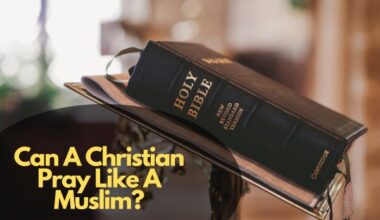The Lord’s Prayer is a timeless thread that permeates the hearts and thoughts of Christians everywhere in the religious ritual shade. This profound invocation, which has its roots in the teachings of Jesus Christ, crosses sectarian borders and provides a universal pathway to the divine.
We take a trip that examines not just the words said but also the transformational power they possess as we look into the layers of meaning that surround the Lord’s Prayer. Praying the Lord’s Prayer invites believers to discover comfort, direction, and a close relationship with the sacred.
30 Effective Facts About The Lord’s Prayer
Facts about the Lord’s Prayer illuminate its profound significance in Christianity. This prayer, taught by Jesus to his disciples, holds a central place in Christian worship and spiritual life. Found in the Gospel of Matthew and Luke, it serves as a universal template for believers, emphasizing key theological concepts. Its concise structure covers themes of worship, forgiveness, and divine sovereignty.
Various Christian denominations recite slightly different versions, reflecting linguistic and theological nuances. The Lord’s Prayer stands as a unifying force, symbolizing the shared devotion of Christians globally and embodying the timeless teachings imparted by Jesus to guide believers in their spiritual journey. Let’s explore on the effective facts about the Lord’s Prayer
1. Origin: The Lord’s Prayer, also known as the Our Father, comes from the Bible, specifically from the Gospel of Matthew (6:9-13) and the Gospel of Luke (11:2-4).
2. Authorship: It is attributed to Jesus Christ, who taught it to his disciples as a model for prayer.
3. Matthew’s Version: The longer and more commonly known version of the Lord’s Prayer is found in the Gospel of Matthew.
4. Luke’s Version: A shorter version of the prayer is present in the Gospel of Luke.
5. Teaching Moment: Jesus taught the Lord’s Prayer in response to his disciples’ request to teach them how to pray.
6. Address to God: The prayer begins with “Our Father,” emphasizing a personal and communal relationship with God.
7. Sacred Language: The prayer has been translated into numerous languages and is recited by Christians around the world.
8. Traditional Text: The traditional English text of the Lord’s Prayer is based on the King James Version of the Bible.
9. Catholic Version: In the Catholic tradition, the prayer is slightly different, with the ending phrase being “deliver us from evil” rather than “lead us not into temptation.”
10. Protestant Version: Protestant denominations generally use the “lead us not into temptation” wording.
11. Common Ground: Despite denominational differences, the Lord’s Prayer is a unifying element for Christians of various traditions.
12. Liturgical Use: The Lord’s Prayer is often recited during Christian worship services.
13. Seven Petitions: The prayer consists of seven petitions, addressing various aspects of life and faith.
14. Hallowed Be Thy Name: This phrase emphasizes the holiness and sanctity of God’s name.
15. Thy Kingdom Come: A petition for the coming of God’s kingdom on earth.
16. Thy Will Be Done: An acknowledgment of God’s sovereignty and a submission to His will.
17. On Earth as It Is in Heaven: This phrase expresses the desire for God’s will to be realized on Earth as it is in Heaven.
18. Give Us This Day Our Daily Bread: A request for God’s provision of daily sustenance.
19. Forgive Us Our Trespasses: An admission of sin and a plea for God’s forgiveness.
20. As We Forgive Those Who Trespass Against Us: A commitment to forgive others as God forgives us.
21. Lead Us Not into Temptation: A request for God’s guidance and protection against temptation.
22. Deliver Us from Evil: A plea for God’s deliverance from the influence and power of evil.
23. Amen: The prayer concludes with the word “Amen,” indicating agreement and affirmation.
24. Ecumenical Significance: The Lord’s Prayer is often used as an ecumenical bridge, fostering unity among different Christian denominations.
25. In Art and Literature: The prayer has been a source of inspiration for artists, poets, and writers throughout history.
26. Musical Settings: Many composers, including classical and contemporary, have set the Lord’s Prayer to music.
27. Catechetical Tool: The prayer is often used as a teaching tool in Christian catechism and education.
28. Memorization: Many Christians memorize the Lord’s Prayer as part of their spiritual practice.
29. Public Events: The Lord’s Prayer is sometimes recited at public events and ceremonies.
30. Global Recognition: Regardless of denominational differences, the Lord’s Prayer is recognized and revered by Christians worldwide.
Why Pray The Lord’s Prayer
Here are some reasons why individuals might choose to pray the Lord’s Prayer:
1. Biblical Foundation
The Lord’s Prayer is directly taken from the teachings of Jesus as recorded in the Bible. Many Christians view it as a model prayer provided by Jesus himself.
2. Liturgical Tradition
The Lord’s Prayer has been incorporated into Christian liturgy and worship services for centuries. It is a central part of many Christian denominations’ worship practices, including in the celebration of the Eucharist (Communion).
3. Community Connection
The Lord’s Prayer is often recited collectively in Christian worship settings, fostering a sense of unity and community among believers. It is a shared expression of faith that transcends denominational differences.
4. Teaching and Guidance
The prayer serves as a guide for believers on how to approach God in prayer. It covers essential aspects of prayer, including acknowledging God’s holiness, seeking His will, asking for daily provisions, seeking forgiveness, and requesting guidance and protection.
5. Universal Applicability
The themes and petitions in the Lord’s Prayer are broad and applicable to various life situations. It can be a source of comfort, inspiration, and guidance for individuals facing different challenges and circumstances.
6. Spiritual Discipline
For many Christians, regularly praying the Lord’s Prayer is seen as a spiritual discipline. It provides a structured and comprehensive framework for personal and communal prayer.
7. Historical Significance
The Lord’s Prayer has a rich history within Christianity and has been a source of inspiration for theologians, scholars, and believers throughout the centuries. Its enduring popularity is rooted in its timeless and universal appeal.
Conclusion
The Lord’s Prayer reverberates over time and space like a melodious refrain in the symphony of spiritual activities. Its seeming simplicity conceals a richness of meaning that cuts beyond linguistic and cultural barriers.
Saying the Lord’s Prayer is not merely a ceremonial recitation; rather, it is a significant demonstration of faith and the eternal influence of words infused with heavenly insight. Let us take with us the knowledge that when we recite these holy phrases, we engage in a communion that transcends this world as we get to the end of our investigation.





